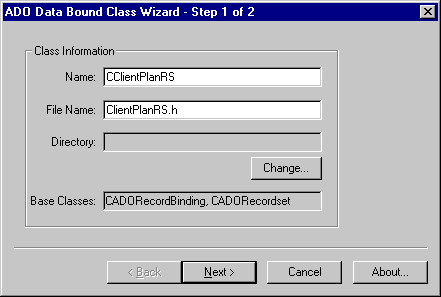Introduction
For an assignment at work, I needed to create a set of classes that would use ADO to read from a database. After using tons of code from Code Project over the last few months, I decided I would try to give something back.
The benefits of using ADO/OLE DB versus ODBC are:
- speed improvements,
- provider flexibility (if you create a custom OLE DB provider, you can use these classes for your consumer),
- industry standard for database access, ...
If you're going to be using VB, there is no reason to not use ADO almost always because of the way VB provides a very user friendly interface to ADO.
There is not a user friendly interface available for ADO with Visual C++. There are code examples on MSDN and other sites (for instance Bob Place's article on CodeGuru), but there is no support built into MFC. Anyone who is familiar with MFC and the class wizard, certainly appreciates the help given when using ODBC for static binding. Static binding is a quicker means of reading the database when you will be reading/updating several rows from a table. For my purposes, this efficiency was very essential. These classes and the wizard make doing this a breeze.
The interface presented with CDatabase, CRecordset and CDBVariant is very sufficient to perform dynamic binding and is standard MFC. I wanted an interface for using ADO that was basically equivalent to this.
Like all programmers who enjoy code reuse, the first step for creating this interface was seeing what was already available. I found two articles here on CodeProject that provided very nearly exactly what I was after. They are the ADO classes by Carlos Antollini and the ADO Data Bound class wizard by Ly Nguyen.
Basically, my work involved integrating these and providing an interface as similar to CRecordset and CDatabase as possible.
The classes provide all the functionality for dynamic binding (while also converting to MFC types from VARIANT types) and a very simple interface for static binding.
All the details and exceptions involving ADO and COM are encapsulated.
Here is a very simple example of using the classes with dynamic binding:
Here is a very simple example of using the classes with static binding:
First, we use the included wizard (Ly Nguyen's application slightly modified) to generate the class that derives from both CADORecordBinding and from CADORecordset:

In later steps, the wizard allows you to specify a table and the wizard generates the binding macro calls (ADO_FIXED_LENGTH_ENTRY, etc) for you. Of course, you'll have to add the header to your project file and add the path to the .dll's headers in your project settings:

First the CADORecordset derived class (the wizard's output):
class CClientPlanRS : public CADORecordBinding, public CADORecordset
{
BEGIN_ADO_BINDING(CClientPlanRS)
ADO_FIXED_LENGTH_ENTRY ( 1,
adInteger, m_lClient_Key, m_ulClient_KeyStatus, TRUE)
ADO_VARIABLE_LENGTH_ENTRY2( 2,
adVarWChar, m_szClient_Name, sizeof(m_szClient_Name),
m_ulClient_NameStatus, TRUE)
ADO_VARIABLE_LENGTH_ENTRY2( 3,
adVarWChar, m_szClient_Description,
sizeof(m_szClient_Description),
m_ulClient_DescriptionStatus, TRUE)
END_ADO_BINDING()
public:
LONG m_lClient_Key;
ULONG m_ulClient_KeyStatus;
CHAR m_szClient_Name[51];
ULONG m_ulClient_NameStatus;
CHAR m_szClient_Description[256];
ULONG m_ulClient_DescriptionStatus;
CClientPlanRS(CADODatabase* pDb, int nCacheSize = -1) :
CADORecordBinding(),
CADORecordset(pDb, nCacheSize)
{ SetRecordBinding(this); }
};
And now using it. We'll use the Microsoft OLE DB provider for ODBC, so we don't have to specify the provider parameter. Also we will connect using an ODBC DSN.
It is important to note that these classes do not throw exceptions. Rather their methods return BOOLs.
The code itself is heavily commented so please review it for further details.
History
- 12th August, 2002: Initial version
License
This article has no explicit license attached to it, but may contain usage terms in the article text or the download files themselves. If in doubt, please contact the author via the discussion board below.
A list of licenses authors might use can be found here.
